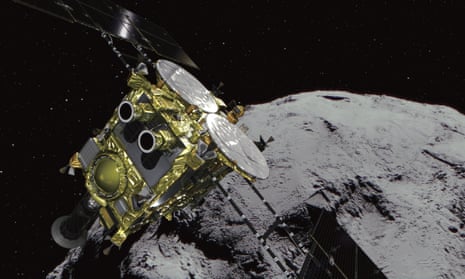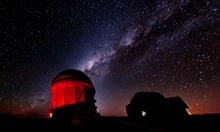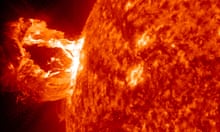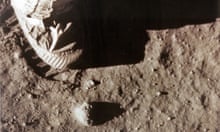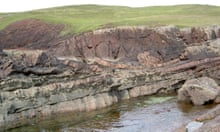A Japanese spacecraft has successfully landed on a distant asteroid where it hopes to collect samples that could shed light on the evolution of the solar system.
Scientists at the Japan Aerospace Exploration Agency (Jaxa) observing the landing from a control room on the southern island of Tanegashima applauded and made “V” for victory signs after the Hayabusa2 probe landed on the asteroid on Thursday morning local time.
“The touchdown is successful,” Jaxa spokesman Takayuki Tomobe said.
The agency said the probe had been working normally above Ryugu asteroid, some 300m km (185m miles) from Earth.
Its landing is the second time the probe has touched down on the desolate asteroid as part of a complex mission that has also involved sending rovers and robots.
[PPTD] July 11 at 10:51 JST: Gate 5 check. The state of the spacecraft is normal and the touchdown sequence was performed as scheduled. Project Manager Tsuda has declared that the 2nd touchdown was a success!
— HAYABUSA2@JAXA (@haya2e_jaxa) July 11, 2019
The mission hopes to collect pristine materials from beneath the surface of the asteroid that could provide insights into what the solar system was like at its birth 4.6bn years ago. The agency said it would be the first time a probe has taken particles from below the surface of an asteroid.
To get at those crucial materials, in April an “impactor” was fired from Hayabusa2 towards Ryugu in a risky process that created a crater on the asteroid’s surface and stirred up material that had not previously been exposed to the atmosphere.
Jaxa said the samples could contain organic materials and water.
“This is the second touchdown, but doing a touchdown is a challenge whether it’s the first or the second,” Yuichi Tsuda, Hayabusa2 project manager, told reporters ahead of the mission.
“The whole team will do our best so that we’ll be able to complete the operation,” he said.
Hayabusa2’s first touchdown was in February, when it landed briefly on Ryugu and fired 5g pellet at more than 1,050km per hour (650mph) into the asteroid’s surface to puff up dust for collection, before blasting back to its holding position.
Thursday’s second touchdown required special preparations because any problems could have meant the probe lost the precious materials already gathered during its first landing.
The probe began its descent on Wednesday from its usual stationary position 20km above the asteroid, and is believed to have touched down on a targeted area located about 20 metres from the artificial crater’s centre.
During its brief time on the asteroid, Hayabusa2 collected samples from the crater formed in February via a tube that retrieved the unidentified “ejecta” as it floated up.
A photo of the crater taken by Hayabusa2’s camera showed that parts of the asteroid’s surface are covered with materials that are “obviously different” from the rest of the surface, mission manager Makoto Yoshikawa told reporters. “I’m really looking forward to analysing these materials.”
Tsuda said: “It would be safe to say that extremely attractive materials are near the crater.”
The probe will return to Earth next year, when scientists hope to learn more about the history of the solar system and even the origin of life from its samples.
At about the size of a large refrigerator and powered by solar panels, Hayabusa2 is the successor to Jaxa’s first asteroid explorer, Hayabusa – Japanese for falcon.
That probe returned with dust samples from a smaller, potato-shaped asteroid in 2010, despite various setbacks during its epic seven-year odyssey and was hailed as a scientific triumph.
Hayabusa2’s photos of Ryugu, which means “Dragon Palace” in Japanese and refers to a castle at the bottom of the ocean in an ancient Japanese tale, show the asteroid has a rough surface full of boulders.
The Hayabusa2 mission was launched in December 2014 at a cost of around 30bn yen ($270m). It reached its stationary position above Ryugu in June last year after travelling 3.2bn km on an elliptical orbit around the sun for more than three years, according to Kyodo news agency.
If the rest of its historical mission goes to plan, Hayabusa2 will return to its landing site in Woomera, South Australia, at the end of 2020.
In 2005, NASA’s Deep Impact project succeeded in creating an artificial crater on a comet but only for observation purposes.
